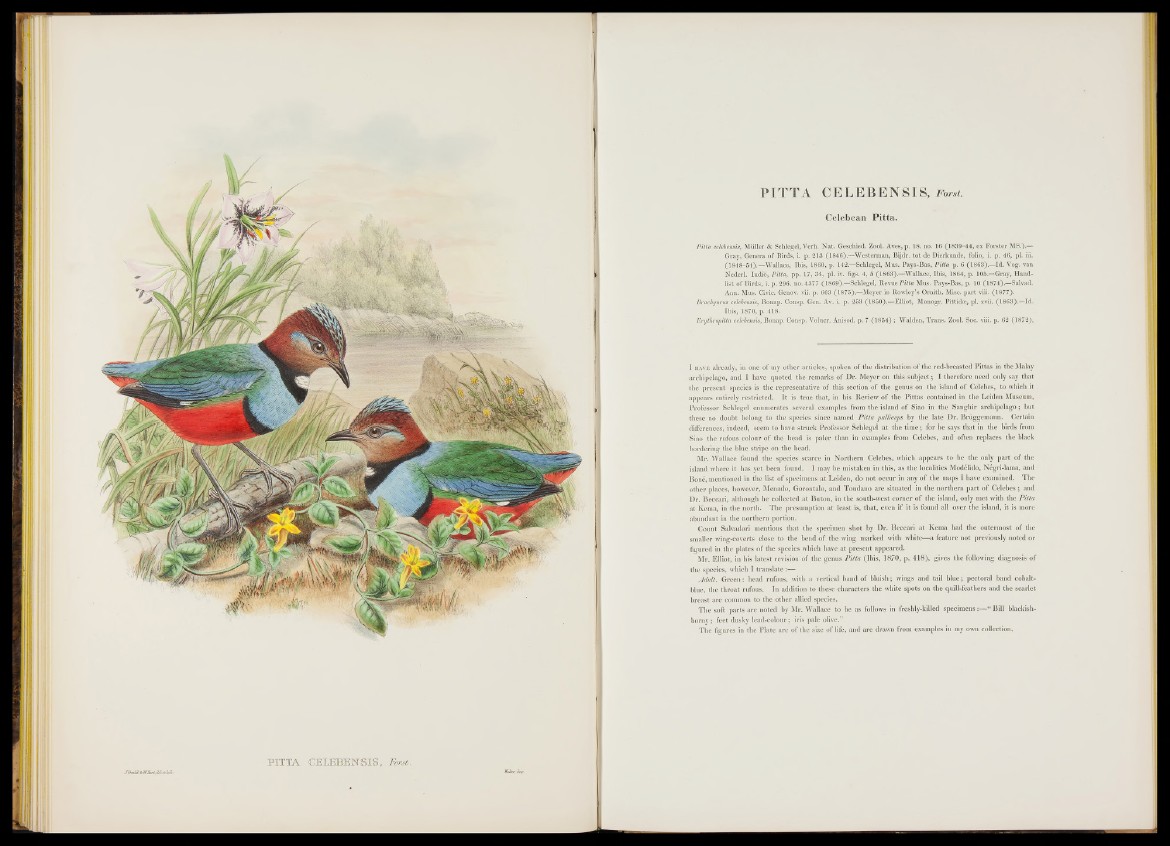
JGmlcL k WHart. Irl ft bA '
PITTA. CEIEBENSIS, F a r si.
PITTA CELEBENSIS, Forst.
Celebean Pitta.
Pitta celebensis, Miiller & Schlegel, Verh. Nat. Geschied. Zool. Ayes, p. 18. no. 16 (1839-44, ex Forster MS.).—
Gray, Genera of Birds, i. p. 213 (1846).—Wester man, Bijdr. tot de Dierkunde, folio, i. p. 46, pi. iii.
(1848-54).—Wallace, Ibis, 1860, p. 142.—Schlegel, Mus. Pays-Bas, Pitta p. 6 (1863).—Id. Yog. van
Nederl. Indie, Pitta, pp. 17, 34, pi. iv. figs. 4, 5 (1863).—Wallace, Ibis, 1864, p. 105.—Gray, Handlist
of Birds, i. p. 296. no. 4377 (1869).—Schlegel, Revue Pitta Mus. Pays-Bas, p. 10 (1874).—Salvad.
Ann. Mus. Civic. Genov, vii. p. 663 (1875).—Meyer in Rowley’s Or'nith. Misc. p art viii. (1877).
Brachyurus celebensis, Bonap. Consp. Gen. Av. i. p. 253 (1850).—Elliot, Monogr. Pittidse, pi. xvii. (1863).—Id.
Ibis, 1870, p. 418.
ErytJiropitta celebensis, Bonap. Consp. Volucr. Anisod. p. 7 (1854) ; Walden, Trans. Zool. Soc. viii. p. 62 (1872).
I have already, in one of my other articles, spoken o f the distribution o f the red-breasted Pittas in the Malay
archipelago, and I have quoted the remarks of Dr. Meyer on this su b ject; I therefore need only say that
the present species is the representative o f this section of the genus* on the island o f Celebes, to which it
appears entirely restricted. I t is true that, in his Review o f the Pittas contained in the Leiden Museum,
Professor Schlegel enumerates several examples from the island o f Siao in the Sanghir archipelago; but
these no doubt belong to the species since named Pitta palliceps by the late Dr. Briiggemann. Certain
differences, indeed, seem to have struck Professor Schlegel a t the tim e ; for he says that in the birds from
Siao the rufous colour o f the head is paler than in examples from Celebes, and often replaces the black
bordering the blue stripe on the head.
Mr. Wallace found the species scarce in Northern Celebes, which appears to be the only p a rt o f the
island where it has yet been found. I may be mistaken in this, as the localities Modelido, Negri-Iama, and
Bone, mentioned in the list o f specimens a t Leiden, do not occur in any o f the maps I have examined. The
other places, however, Menado, Gorontalo, and Tondano are situated in the northern p art o f Celebes; and
Dr. Beccari, although he collected at Buton, in the south-west corner o f the island, only met with the Pitta
at Kema, in the north. The presumption at least is, that, even if it is found all over the island, it is more
abundant in the northern portion.
Count Salvadori mentions th at the specimen shot by Dr. Beccari at Kema had the outermost o f the
smaller wing-coverts close to the bend o f the wing marked with white—a feature not previously noted or
figured in the plates o f the species which have a t present appeared.
Mr. Elliot, in his latest revision of the genus Pitta (Ibis, 1870, p. 4 1 8 ), gives the following diagnosis of
the species, which I translate
Adult. G re e n : head rufous, with a vertical band of bluish; wings and tail b lu e ; pectoral band cobalt-
blue, the throat rufous. In addition to these characters the white spots on the quill-feathers and the scarlet
breast are common to the other allied species.
The soft parts are noted by Mr. Wallace to be as follows in freshly-killed s p e c im e n s “ Bill blackish-
horny; feet dusky lead-colour ; iris pale olive.”
The figures in the Plate are of the size of life, and are drawn from examples in my own collection.